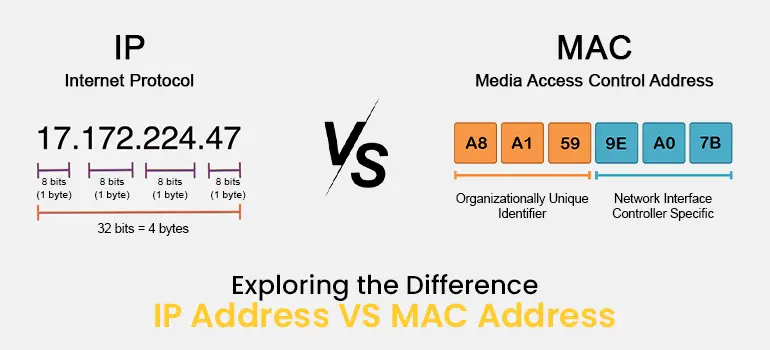Computer Networking
Exploring the Difference: IP Addresses vs. MAC Addresses
Understanding the differences between IP addresses and MAC addresses is crucial in the realm of networking. Both identifiers serve distinct roles in the process of data transmission, facilitating communication between devices on a network. Although they are both vital components of networking, they operate at different layers of the OSI model and serve different functions.
In this blog, we will explore the key differences between IP addresses and MAC addresses, including their unique characteristics, functions, and how they contribute to the seamless operation of modern networks.
What is an IP Address?
- An IP (Internet Protocol) address is a unique numerical label assigned to each device that connects to a network.
- It serves as an identifier, allowing devices to communicate with each other over a local network or the internet.
- IP addresses are essential for routing data packets to their intended destinations, enabling seamless communication across the vast network infrastructure.
- There are two main types of IP addresses: IPv4 and IPv6.
- IPv4 addresses are the most widely used and consist of four sets of numbers separated by periods.
- However, with the depletion of IPv4 addresses, IPv6 addresses are becoming increasingly popular.
- IPv6 addresses are represented by a longer hexadecimal format.
- In essence, IP addresses play a fundamental role in modern networking by facilitating the exchange of data between devices and enabling the interconnectedness of the digital world.
What is a MAC Address?
- MAC addresses are unique identifiers assigned to network interfaces of devices.
- Unlike IP addresses, MAC addresses are hardcoded into the device's network interface hardware and cannot be changed based on network configuration.
- These addresses are globally unique, meaning that no two devices on the same network share the same MAC address.
- In the data link layer of the OSI model, MAC addresses facilitate the delivery of data frames between devices on the same network segment.
- Address Resolution Protocol (ARP) is used to map IP addresses to MAC addresses, allowing devices to communicate within a local network.
- Network switches use MAC addresses to forward data packets to the correct device based on its physical location within the network.
- It's important to note that MAC addresses are non-routable and are only relevant within the local network segment, meaning that they are not used for communication across different networks.

Difference Between IP Address and MAC Address
1. Purpose:
- IP Address:
- Serves multiple purposes beyond internet connectivity.
- Identifies hosts uniquely, enabling internet access and interaction with network devices.
- Determines the location of hosts, aiding in tracking malicious activities.
- MAC Address:
- Facilitates secure location of senders and receivers within the network.
- Unique hardware identifier assigned to devices for tracking and preventing unauthorized network access.
2. Address Type:
- IP address: Logical or software address.
- MAC address: Hardware or physical address hardcoded into devices.
3. Address Provider:
- IP address: Provided by Network Administrator, DHCP protocol, or ISP.
- MAC address: Assigned by device manufacturer and integrated into Network Interface Card (NIC).
4. Address Length and Representation:
- IP address: IPv4 (32-bits) or IPv6 (128-bits), expressed in binary format with dots.
- MAC address: 48-bit address, written in hexadecimal format with hyphens or colons.
5. Network Classes:
- IP addresses utilize network classes (A, B, C, D, E) for connection, unlike MAC addresses.
6. Subnetting:
- IP addresses employ subnetting, dividing networks into smaller segments.
7. Flexibility:
- IP addresses are adaptable, changing with network connections, while MAC addresses remain fixed.
8. Layer of Implementation:
- IP addresses are implemented in the Network layer, while MAC addresses reside in the Data-Link layer of the OSI or TCP/IP reference model.
| IP Address |
MAC Address |
| The term IP address stands for Internet Protocol address. |
Media Access Control address is commonly referred to as MAC address. |
| A device that has an IP address can collect data through the RARP method (Reverse Address Resolution Protocol). |
ARP (Address Resolution Protocol) is used by devices with MAC addresses to extract data. |
| It's not possible for IP addresses to resolve issues related to MAC (Media Access Control) addresses. |
The MAC address can be useful in resolving IP address issues. |
| An IP address has the ability to be broadcasted or multi-casted. |
Broadcasting can be performed using MAC addresses. |
Conclusion
IP and MAC addresses are unique identifiers in computer networks, but they serve different purposes. While IP addresses facilitate communication between devices across different networks, MAC addresses are used for communication within the local network segment. IP addresses provide global connectivity, while MAC addresses enable local network communication.
Rahul Bundele
This is a test description.

